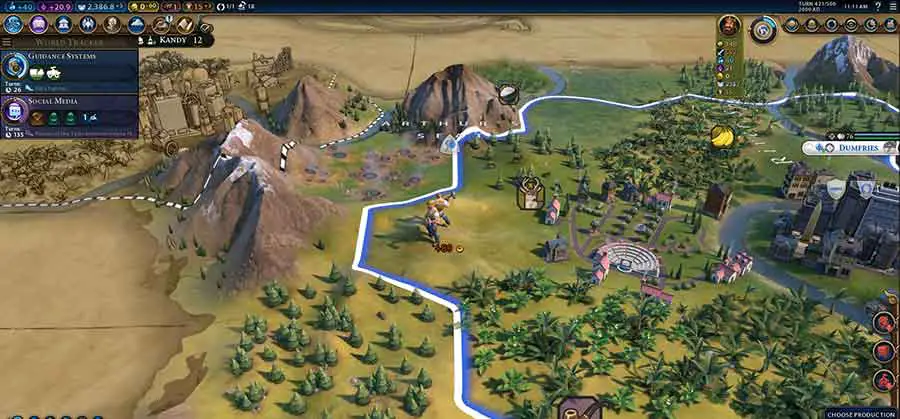
The Builder is available at the very start of the game and it begins with actions called charges. These actions, or charges, are things like making tile improvements or clearing out resources. You can tell how many charges a Builder has by its icon or by looking at its information menu. If the Builder icon has two Builders that means it has two charges left. A new Builder, unless the base number is increased through governors and policy cards, starts out with 3 charges.
You use Builders by moving them to the tile you want worked. Builders start with three available charges, and each harvest operation or tile improvement uses up one charge. When all the Builder’s charges are used it disappears from the game.
Affiliate Link
Affiliate Link
Affiliate Link
On the next turn, once the Builder is at the tile you want to work, you choose the action from their information bar and the action is completed instantly, regardless of whether you’re harvesting a resource or constructing an improvement like a mine. Builders can also be used to get technology and civics boosts.
When you select a Builder icons appear on some of the surrounding tiles. Each icon represents the “best things,” at least according to the game, that your Builder can build on that tile. You’ll see icons for farms, encampments and for luxury resources like honey. Most are grayed out until you have the technology available to build the improvement.
Basic Builder Uses
The most fundamental use of a Builder is to clear resources and to build tile improvements. In the early game the ability to clear resources is vital. Although it uses up a Builder charge it provides you with some added resources, like production and food if harvesting a Rainforest. If you simply improve the Rainforest tile by constructing a Lumbermill without first clearing the tile you’ll lose those resources. Whether this is worth using up one Builder charge depends on how badly you need the resources.
The other essential Builder ability is the ability to improve tiles, like building Lumbermills or Farms for example. Like all Civ 6 units, Builders have a limited number of hexes they can move each turn, at the start of the game the Builder is limited to 2 tiles of movement per turn. Builders also can only build within the borders of a city although they can travel from city to city to build improvements.
Creating Improvements
Creating improvements is simple. First move your Builder to the tile you want to improve. Once the Builder has arrived at the tile check the set of icons at the bottom left part of the screen in the information bar. There will be 2 or 3 rows of them and most of them will probably be grayed out, only actions the Builder is able to perform will be active. At the top center of these icons there will be an action your Advisor recommends, like building a lumbermill. Click on it and your Builder will instantly build the improvement, it won’t be built over a number of turns like buildings are. You don’t need to listen to your advisor and can choose to do something else that is active instead, like clearing out the area first to gain the resources from the tile.
Repairing Pillaged Improvements
Builders also repair pillaged improvements but can’t repair damaged buildings, that needs to be done using the city’s menu production screen. Once the Builder arrives at a pillaged tile a repair icon will be available for use and taking this action will not use up any charges from the Builder. Another thing that does not use up a Builder charge is removing tile improvements.
Need some help deciding where to build cities or how many cities to build? Read my article about choosing where to settle and my page about how many cities to build.
Civ 6 Builder Strategy
Like most things in Civilization VI, your early strategy depends on your surroundings and any threats that are close by. If there are no threats nearby, like Barbarians, and you have some great tiles around your city that can be upgraded or harvested, then creating a Builder after a Scout is an option worth pursuing. Otherwise, it’s best to wait several turns before creating a Builder. Normally it’s better to build a Scout first, then a Slinger to defend your city from any hostiles like Barbarians. Depending on the situation you might build either another military unit of some type to help take care of a Barbarian camp or another Settler to establish another city, or both, so a Builder can be as late as the fifth item you choose to create.
The first builder you create should be used to improve available resources and then to build farms if you can’t improve anything else. The Builder should also be focused on achieving technology boosts along with tile improvements, like improving any 3 tiles to boost the Craftsmanship civic. Civics boosts can be coupled with technology boosts as well. For instance, farming a tile will give irrigation technology a boost and still contribute to the Craftsmanship Civic boost as well.
After the first builder the next step can be in one of two directions. First, you can create a Builder for each new city you establish and have him do the same basic things as the first Builder.
Getting Extra Builder Charges
The second option is to wait until the Serfdom policy card becomes available, which is unlocked by the Feudalism Civic in the Medieval Era. Hold off making any new Builders until this becomes available and then build as many as you need, or until the time comes to change policies again. Any newly created Builders get two extra charges because of the Serfdom policy card, meaning you can get a lot more uses out of them, almost twice as much.
If you want to get even more uses out of your Builders establish Liang, The Surveyor, as a governor of one of your cities. With her Guildmaster ability any Builders created in her city get an additional charge. That, coupled with the Serfdom policy card, will give Builders created in her city 6 charges instead of 3.
Another method to gain extra Builder charges is to build the Pyramid wonder. Once finished it gives all your Builders another charge, even Builders who have already been created.
Mangus the Governor
If you have Rise and Fall establish Magnus as the Governor for one of your cities since he grants additional income from cleared resources, just be sure to place him in the city having the tiles your Builder is improving. Early in the game this extra production is great for using it on other needed things. Once a Builder has finished work in one city move Magnus to the next city having tiles that can be improved.
Although obvious it’s worth mentioning that high yield tiles and mines should be improved first by Builders. Farms are almost always your lowest priority. In order to maximize their adjacency bonuses the optimal layout is to build Farms together like a pyramid.
If you want to read up on how to spread religion go to this page on my website.
Civ 6 Builders Won’t Build
If your Builders won’t build anything the first thing to check is to see if they’re on a tile that can be improved. If a Builder is on a workable tile make sure you have the right technology and/or civic researched. Also make sure the Builder is within a city’s cultural borders. At the beginning this will be a 7-tile circle around the city. If the Builder is outside the city borders, then he won’t be able to build anything.
There are also certain circumstances when your Builders can’t build what you want them to build. You will be unable to build a farm if there isn’t any water close by or a mine if you don’t have Mining researched. Special ecological conditions, like a drought, can prevent you from building certain tile improvements, like Farms, as well.
Civ 6 Builders Disappearing
When a Builder disappears it’s because of the design of the game and not a bug. Once all a Builder’s charges are used up, which is typically 3, the unit disappears from the game.
Don’t forget to visit my YouTube channel at https://www.youtube.com/channel/UCcWU6qxVisK93h5guKRVtdg
